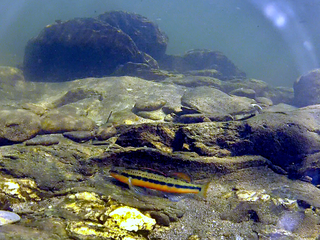
The tangerine darter or river slick is a small species of freshwater ray-finned fish, a darter from the subfamily Etheostomatinae, part of the family Percidae, which also contains the perches, ruffes and pikeperches. It is found in the eastern United States. It grows to a length of 4.3 to 7.1 inches, males being bright orange-red while females are yellow. It is insectivorous, picking insect larvae off aquatic plants and the riverbed, and sometimes rolling small stones over to expose prey. It breeds in late spring and early summer, typically in shallow sandy or gravelly riffles. Pollution and habitat degradation may be a problem in parts of its range, however it is a fairly common fish with a wide range and the International Union for Conservation of Nature has classified its conservation status as being of "least concern".
The Bayou darter is a rare species of freshwater ray-finned fish, a darter from the subfamily Etheostomatinae, part of the family Percidae, which also contains the perches, ruffes and pikeperches. It is endemic to western Mississippi in the United States, where it is found only in Bayou Pierre and its tributaries. Its typical habitat is fast-flowing creeks and streams, in riffles and in areas between riffles with firm gravel bottoms. It feeds on small insects and their larvae. Breeding probably takes place twice a year, in spring and late summer. The population of this fish is declining due to loss of suitable habitat. This is caused by siltation and pollution, particularly erosion caused by changes in land use. The International Union for Conservation of Nature has assessed its conservation status as being "endangered".

The channel darter is a species of freshwater ray-finned fish, a darter from the subfamily Etheostomatinae, part of the family Percidae, which also contains the perches, ruffes and pikeperches. It is native to North America where it typically occurs in the sandy or gravelly shallows of lakes and in small and medium-sized rivers in riffles over sand, gravel or rock bottoms. It is a small fish ranging from 34 to 72 mm in length, olive brown with darker speckles and sometimes with a dark spot below the eye and dark blotches along the flank. It feeds mostly on insect larvae and other small invertebrates and breeds in small streams. This species is listed as threatened by the Canadian Species at Risk Act (SARA) but overall it has a wide range and numerous sub-populations and the International Union for Conservation of Nature has rated it as a "least concern species".

The dusky darter is a species of freshwater ray-finned fish, a darter from the subfamily Etheostomatinae, part of the family Percidae, which also contains the perches, ruffes and pikeperches. It is found in, but not confined to, both large and small rivers, and shallow creeks, in the eastern, southern, and southeastern United States, particularly the Mississippi River drainage system.
The harlequin darter is a species of ray-finned fish, a darter from the subfamily Etheostomatinae, part of the family Percidae which includes the perches, ruffes and pike-perches. It is endemic to the eastern half of the United States.
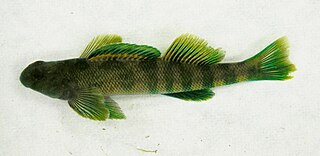
The greenside darter is a species of freshwater ray-finned fish, a darter from the subfamily Etheostomatinae, part of the family Percidae, which also contains the perches, ruffes and pikeperches. It inhabits swift riffles in the eastern United States and southern Ontario.

The fantail is a species of freshwater ray-finned fish, a darter from the subfamily Etheostomatinae, part of the family Percidae, which also contains the perches, ruffes and pikeperches. It is widely distributed across streams in North America.
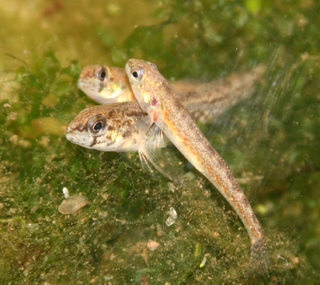
Etheostoma exile, the Iowa darter, is a species of freshwater ray-finned fish, a darter from the subfamily Etheostomatinae, part of the family Percidae, which also contains the perches, ruffes and pikeperches. It is, along with about 17 other species of darters, is native to the lakes and streams of Iowa.
The Cumberland snubnose darter is a species of freshwater ray-finned fish, a darter from the subfamily Etheostomatinae, part of the family Percidae, which also contains the perches, ruffes and pikeperches. This species is found in the middle Cumberland River drainage in Tennessee, Kentucky, Virginia, North Carolina, Georgia, and Alabama. It is absent in reaches above the Big South Fork, rare in North Carolina, and absent in western tributaries of the Tennessee River. While research on the ecology of E. atripinne is not extensive, what is known is they are usually found in small to medium freshwater streams in gravel riffle areas where their eggs can attach to the substrate and be left unguarded. E. atripinne can be found within a wide range of depths in its environment, leading its being classified as benthopelagic. While its global status is secure, the American Fisheries Society labels it with a status of “Special Concern”.

The orangefin darter is a species of freshwater ray-finned fish, a darter from the subfamily Etheostomatinae, part of the family Percidae, which also contains the perches, ruffes and pikeperches. It is found in Barren River and Green River systems in Tennessee and Kentucky.
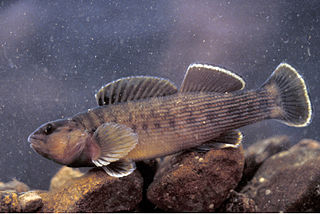
The bluebreast darter is a small species of freshwater ray-finned fish, a darter from the subfamily Etheostomatinae, part of the family Percidae, which also contains the perches, ruffes and pikeperches. It is endemic to the eastern United States from New York and Illinois to Tennessee and North Carolina.
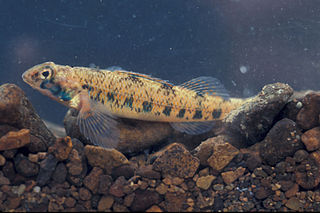
The blueside darter is usually found in the Tennessee River drainage in Tennessee, Alabama, North Carolina, and Virginia, and less commonly found in Bear Creek, Shoal Creek, and Barren Fork.

Etheostoma rufilineatum, the redline darter, is a species of freshwater ray-finned fish, a darter from the subfamily Etheostomatinae, part of the family Percidae, which also contains the perches, ruffes and pikeperches. It is endemic to the southeastern United States.

The snubnose darter is a species of freshwater ray-finned fish, a darter from the subfamily Etheostomatinae, part of the family Percidae, which also contains the perches, ruffes and pikeperches. It is endemic to the southeastern United States.
The Citico darter is a threatened species freshwater ray-finned fish, a darter from the subfamily Etheostomatinae, part of the family Percidae, which also contains the perches, ruffes and pikeperches. It is native to Tennessee. This species was formerly subsumed within Etheostoma percnurum. The E. percnurum group now consists of four distinct species: E. percnurum, E. marmorpinnum, E. lemniscatum, and E. sitikuense.

The orangethroat darter is a species of freshwater ray-finned fish, a darter from the subfamily Etheostomatinae, part of the family Percidae, which also contains the perches, ruffes and pikeperches. It is endemic to the central and eastern United States where it is native to parts of the Mississippi River Basin and Lake Erie Basin. Its typical habitat includes shallow gravel riffles in cooler streams and rocky runs and pools in headwaters, creeks, and small rivers, with sand, gravel, rubble, or rock substrates. It forages on the bottom for the aquatic larvae of midges, blackfly, mayfly and caddisfly, as well as isopods and amphipods. Spawning takes place in spring, the selected sites often being the upper stretches of riffles with sandy and gravelly bottoms interspersed with larger cobble. Reproductive success is high in this species. No particular threats have been identified, and the International Union for Conservation of Nature has assessed its conservation status as being of "least concern".
The Tippecanoe darter is a species of freshwater ray-finned fish, a darter from the subfamily Etheostomatinae, part of the family Percidae, which also contains the perches, ruffes and pikeperches. It is endemic to the eastern United States.
The wounded darter is a species of freshwater ray-finned fish, a darter from the subfamily Etheostomatinae, part of the family Percidae, which also contains the perches, ruffes and pikeperches. It is endemic to the eastern United States. Its range includes the upper Tennessee River drainage, western Virginia, western North Carolina, and eastern Tennessee. Its typical habitat is among boulders or coarse rubble and cobble, often with overhanging ledges, in medium to large slow-moving rivers. It feeds on small insect larvae, especially midge larvae. Spawning occurs when the water warms up in late spring. Females deposit clutches of adhesive eggs on the underside of rock ledges or slabs, and the male guards the nest. The population trend of this fish seems to be decreasing slowly but it is a relatively common species with numerous sub-populations, and the International Union for Conservation of Nature has assessed its conservation status as being of "least concern". The greatest threat comes from impoundment, and a management plan is in place, including captive breeding.

The gilt darter is a species of freshwater ray-finned fish, a darter from the subfamily Etheostomatinae, part of the family Percidae, which also contains the perches, ruffes and pikeperches. It can be found in a number of states in the Mississippi River drainage of the United States although it has been extirpated from some river systems in which it was at one time present, mostly due to siltation and pollution problems. Males are more colorful than females and can grow to a length of about 9 cm (3.5 in). It is a benthic fish that feeds primarily on small aquatic insect larvae. Males form territories during the breeding season in late spring and early summer. Spawning typically takes place at the upper ends of riffles with sandy and gravelly bottoms interspersed with larger cobbles. Some organisations are endeavouring to conserve populations of the gilt darter and re-introduce it to states where the fish has been extirpated but suitable habitat still exists.

The blackbanded darter is a species of freshwater ray-finned fish, a darter from the subfamily Etheostomatinae, part of the family Percidae, which also contains the perches, ruffes and pikeperches. It is native to the river systems of the southeastern United States where it is found in the states of Tennessee, Georgia, Florida, Mississippi, Alabama, and Louisiana. It lives over sandy or gravelly bottoms in smaller rivers and streams and its color varies depending on the different habitats in which it lives. It feeds on small insect larvae and is itself preyed on by larger fish. It spawns between February and June depending on locality. It is generally a common fish throughout most of its range.















